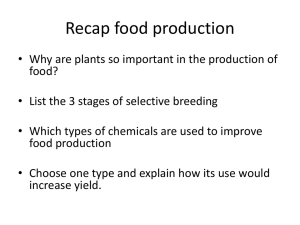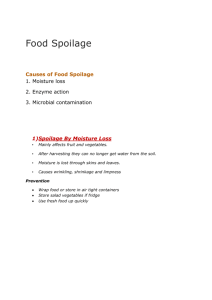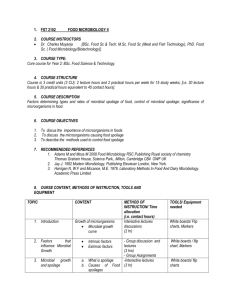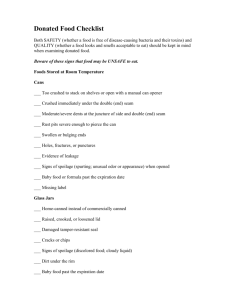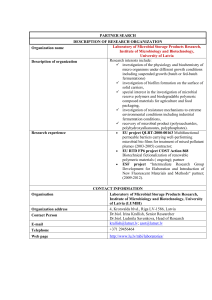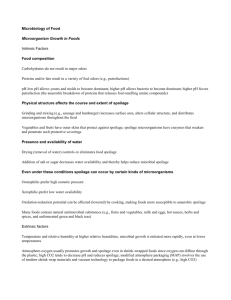Lesson 1.4
advertisement
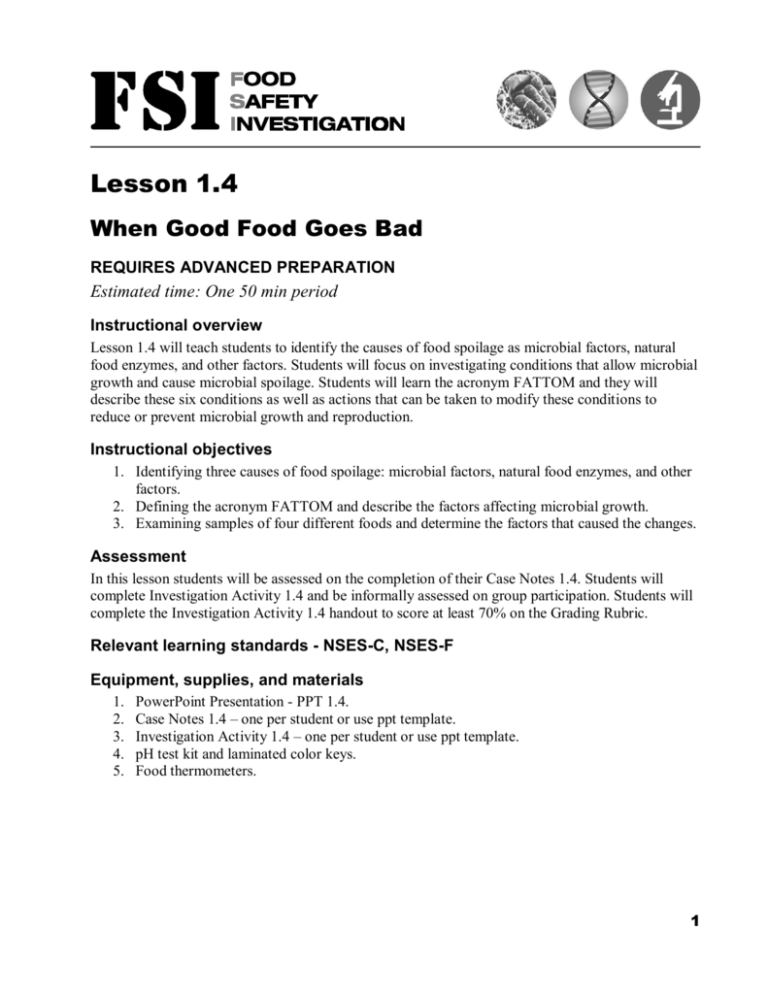
Lesson 1.4 When Good Food Goes Bad REQUIRES ADVANCED PREPARATION Estimated time: One 50 min period Instructional overview Lesson 1.4 will teach students to identify the causes of food spoilage as microbial factors, natural food enzymes, and other factors. Students will focus on investigating conditions that allow microbial growth and cause microbial spoilage. Students will learn the acronym FATTOM and they will describe these six conditions as well as actions that can be taken to modify these conditions to reduce or prevent microbial growth and reproduction. Instructional objectives 1. Identifying three causes of food spoilage: microbial factors, natural food enzymes, and other factors. 2. Defining the acronym FATTOM and describe the factors affecting microbial growth. 3. Examining samples of four different foods and determine the factors that caused the changes. Assessment In this lesson students will be assessed on the completion of their Case Notes 1.4. Students will complete Investigation Activity 1.4 and be informally assessed on group participation. Students will complete the Investigation Activity 1.4 handout to score at least 70% on the Grading Rubric. Relevant learning standards - NSES-C, NSES-F Equipment, supplies, and materials 1. 2. 3. 4. 5. PowerPoint Presentation - PPT 1.4. Case Notes 1.4 – one per student or use ppt template. Investigation Activity 1.4 – one per student or use ppt template. pH test kit and laminated color keys. Food thermometers. 1 Advanced preparation—Food samples: 1. 2. 3. 4. 5. Bread/moldy bread = moisture Milk/soured milk = time and temperature Cabbage/Sauerkraut = lack of oxygen Cucumber/Pickles = acid Whole Cantaloupe/cut up Cantaloupe = time and food Preparation of food samples *Note the time and date when you manipulated the samples and share this information with the students. 1. A: Put one fresh piece of bred in a Petri dish right before class begins. B: Prepare the moldy bread three days in advance by misting it with water and leaving it in a Petri dish. 2. A: Pour a fresh glass of milk right before class begins. B: Leave a glass of milk at room temperature over night or add a tablespoon of vinegar right before class begins. 3. A: Slice up a head of cabbage right before class begins. B: Pour Sauerkraut in a bowl right before class begins. 4. A: Place whole cucumber on table right before class begins. B: Pour pickles from container into bowl right before class begins. 5. A: Place whole cantaloupe on table right before class begins. B: Cut up cantaloupe and place in a Petri dish two days before class, leave at room temperature. Be sure that whole cantaloupe (sample 5A) stays in room temperature the same amount of time. References and background information 1. Food Science and Safety: George J. Seperich. 2. Food Science and You: Kay Mehas and Sharon Rodgers. 3. Food Safety, Bacteria Spoilage: USDA Food Safety and Inspection Service http://www.fsis.usda.gov/help/FAQs_Food_Spoilage/index.asp 4. Introduction to Food Science: Rock Parker. 5. GAPsNET www.gaps.cornell.edu Interest approach Write FATTOM on the board. Ask students what words are represented by the acronym FATTOM. Tell the students the acronym relates to what living things need to survive. Have the students make a list of what living things need to survive. Examples of student answers: food, water, shelter, and oxygen. F: food (any type of food item that provides nutrients for microorganisms) A: acidity (the pH range where microorganisms can survive or grow) T: temperature (temperature range where microorganisms can survive or grow) T: time (time it takes for microorganisms to reproduce) O: oxygen (some microorganisms need oxygen to grow, some do not) M: moisture (water availability) 2 Lesson 1.4 Classroom procedures Teaching procedures Review from previous lesson. State expectations for today’s lesson. Handout Case Notes 1.4 or show the ppt template for students to organize their notes. Content How are beneficial microorganisms used in the food industry? Name some foods that are produced using beneficial microorganisms. Today we are going to continue to narrow down the suspects list by: 1. Identifying three causes of food spoilage: microbial factors, natural food enzymes, and other factors. 2. Defining the acronym FATTOM and describe the factors affecting microbial growth. 3. Examining samples of four different foods and determine the factors that caused the changes. Another part of tracking down a suspect is to look at the way the crime was committed. Investigators refer to this as the Method of Operation or M.O. Lead discussion on how investigators track down a criminal by using the Method of Operation (M.O.) to determine how a crime was The suspects in our Food Safety Investigation committed. are microorganisms. What are their M.O.’s? The Glossary in Appendix C contains all the definitions in the Unit. Lead discussion on food spoilage and its causes. Food spoilage is the condition in which food becomes undesirable. Spoilage affects the Following is the definition of food spoilage. aroma, texture and/or appearance of food. Ask for student input to identify things that cause food to spoil. You can use an apple to demonstrate natural food enzymes. Cut an apple in half at the beginning of class and let it sit out for a few minutes. The flesh of the apple will begin to brown. This apple is still safe to eat but maybe less desirable. Note: Certain varieties of apples, such as Empire, will exhibit less browning, so try this experiment in advance. Lesson 1.4 There are many ways in which food spoils but we will discuss only three mechanisms including: 1. Microbial factors 2. Natural food enzymes 3. Other factors Natural food enzymes cause foods such as fruits and vegetables to ripen and if allowed to continue will cause spoilage of the product. An enzyme is a complex protein molecule that stimulates or speeds up a specific chemical reaction without itself being used up. 3 Following is a discussion on the other factors of food spoilage. Following is the definition of microbial spoilage. Focus discussion on microbial food spoilage, in particular bacterial spoilage. Students may want to know how the six FATTOM items are related. Microbes need all FATTOM to survive. If one of the six FATTOM is intentionally manipulated by the food industry, microbial growth is modified. This is the basis for many food preservation technologies. For instance: microbial pathogen growth is deterred when the pH is below 4.2, the water activity is below 0.65, and the temperature is above 165ºF. There are many other factors causing food spoilage including: 1. Pests such as insects and rodents 2. Heat and cold 3. Moisture and dryness 4. Oxygen 5. Light 6. Time If foods are mishandled or exposed to these factors they can spoil. Sometimes multiple factors can work together to cause food spoilage. Microbial spoilage: Microorganisms grow and reproduce, causing unwanted changes to the color, odor, taste, and texture of the food. How do microorganisms spoil food? Microorganisms, like all living things, metabolize nutrients in order to grow. They utilize the carbohydrates, fats, and proteins in foods as energy sources for cell growth and reproduction and produce by-products as a result of growth. In accomplishing these tasks, bacteria, yeasts, and molds can cause foods to change color, develop a bad odor or get slimy. Can you name basic things organisms need to survive? Food Water Oxygen Shelter/Environment There are six factors that affect the survival and growth of microorganisms. An easy way to remember them is with the acronym FATTOM. FATTOM: Food, Acid, Time, Temperature, Oxygen, and Moisture. In right conditions, spoilage bacteria reproduce rapidly and large populations can grow in a short amount of time. 1 cell becomes 2 cells, 2 cells become 4 cells, 4 cells become 8 cells, and so on. Their by-products cause changes in the odor, taste, and texture of the food. 4 Lesson 1.4 Spoilage microorganisms can multiply at room or refrigerator temperatures and can make food look, smell, or taste bad. The microorganisms that cause food to spoil are not the same ones that cause foodborne illnesses. Harmful bacteria, viruses, and parasites rarely make food look, smell, or taste bad, so you cannot tell (without laboratory testing) when these microorganisms are present in food. It is a good practice to discard spoiled foods and foods that have been left out of refrigeration for more than 2 hours or have been mishandled. Remember: when in doubt, throw it out! Instruct students to join their Investigative Teams at their lab stations and hand out Investigation Activity 1.4 or show the ppt template to help students organize their notes. In today’s Investigation Activity you will define FATTOM and examine each of these six factors, evaluating their role in the modification of different food samples. Go over directions with students and point out materials at their stations that will help them in their quest to determine the cause(s) of the food spoilage. Reflections for future use. You should complete the Investigation Activity 1.4 by the end of today. Lesson 1.4 5 6 Lesson 1.4 When Good Food Goes Bad Case Notes 1.4 Name: _____________________________Date: ___________________________ Food Spoilage Name three mechanisms that cause food spoilage and an example of each. Factors Examples 1. 2. 3. Additional notes: __________________________________________________________________ _________________________________________________________________________________ _________________________________________________________________________________ _________________________________________________________________________________ _________________________________________________________________________________ _________________________________________________________________________________ _________________________________________________________________________________ Lesson 1.4 7 When Good Food Goes Bad Investigation Activity 1.4 Name: ____________________________ Date:____________________________ The modus operandi (M.O.) refers to the method by which crimes are committed. In our first FSI Module, we are investigating microbial activity. This investigation will help you determine how and under what conditions microorganisms change foods. Examine the samples of food in front of you. Using the materials provided, determine the FATTOM factor(s) that may have affected microbial growth. More than one factor may apply. Record the results in the table provided. Identify each food sample. Observe and write their characteristics. Are they spoiled? Materials provided: Date and time food was taken out of the refrigerator Thermometer pH test kit Description of previous storage conditions (temperature, humidity, light, presence of oxygen) Sample 1 A B Food item: What does the sample look like? Previous handling that influenced sample: Which FATTOM caused the variation between samples? More than one may apply. 8 Lesson 1.4 Sample 2 A B A B Food item: What does the sample look like? Previous handling that influenced sample: pH: Temperature: Which FATTOM caused the variation between samples? More than one may apply. Sample 3 Food item: What does the sample look like? Previous handling that influenced sample: pH: Temperature: Which FATTOM caused the variation between samples? More than one may apply. Lesson 1.4 9 Sample 4 A B A B Food item: What does the sample look like? Previous handling that influenced sample: pH: Temperature: Which FATTOM caused the variation between samples? More than one may apply. Sample 5 Food item: What does the sample look like? Previous handling that influenced sample: pH: Temperature: Which FATTOM caused the variation between samples? More than one may apply. 10 Lesson 1.4 This assignment will be graded using the following Grading Rubric: Maximum Points Assessment Criteria The student answered questions correctly and completed the Investigation Activity 1.4 handout. 13 The student completed their Case Notes. 5 The assignment was neat, organized, and handed in on time. 2 TOTAL Lesson 1.4 Points Scored /20 = % 11
